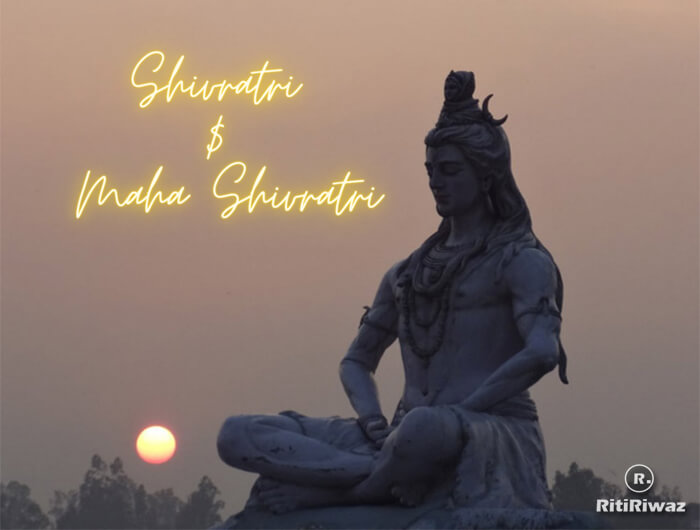Difference between Shivratri and Maha Shivratri

Both Shivratri and Maha Shivratri are celebrated in honor of Lord Shiva but Shivratri falls every month, while Maha Shivratri falls only once a year. Shivratri is made of 2 words – ‘Shiva’ meaning auspiciousness and ‘Ratri’ meaning night. So, Shivratri means an ‘auspicious night’. Shivratri and Mahashivratri are two Hindu festivals that occur on separate months and days.
Maha Shivratri is the Great Night of Shiva and is observed only once a year in the month of Phalgun. Maha Shivratri is the most significant of all the 12 Shivratri in a year. Shivratri occurs every month and falls on the Chaturdashi Tith of Krishna Paksha, so the 14th day of every lunar month is Shivratri.
Maha Shivratri
Goddess Parvati is worshipped along with Lord Shiva on the fasting day of Maha Shivratri on the Chaturdashi of Krishna Paksha of Phalguna month. According to legend, it is said that Lord Shiva and Goddess Parvati got married on the Chaturdashi of Krishna Paksha in the month of Phalgun i.e. Maha Shivratri. It is also said that Shiv performed his famous Anand Tandav Nritya or a dance-drama of creation, and destruction on the eve of Maha Shivratri.
According to another legend the day is related to Samudra Manthan. During Samudra Manthan or the churning of the ocean, various entities were produced from the ocean which was divided into Devas and Asuras. During this process, a pot of poison was also produced along with other things. Nobody was ready to accept the poison, it was then Shiv swallowed the poison and stored it in his neck due to which it became blue hence Shiv is also called Neelkanth. Shiv was advised to stay awake for the whole night as a part of therapy. Gods kept a vigil on him to keep him awake through dances and music. Since then devotees keep a vigil on Maha Shivratri by singing and dancing the whole night.
Some people call Maha Shivratri the night of stillness. They believe that after millions and millions of years of meditation, Lord Shiva became still on one day, and this day is Maha Shivratri.
On this night and day, we honor the God of destruction and so, begin a new cycle of creation. Every wish of the devotee is said to be fulfilled if Rudrabhishek is performed on this day. This day is celebrated with great reverence and devotion throughout the nation & globally.
Shivratri
Shivratri is celebrated on the Chaturdashi Tithi of Krishna Paksha every month. The fourteenth day of every lunar month, which is one day before the Amavasya (New Moon) is known as Shivratri. In simple terms, it is also the day before the new moon. It is also called Pradosh or Masik Shivratri. Badi Shivaratri or Sawan Shivratri is celebrated when Pradosh falls in the month of Shravan.
On Masik Shivratri, Lord Shiva is worshipped in the form of a lingam, which represents the power of fire as well as the convergence of Shiva and Shakti. Chanting ‘om Namah Shivaya during day and night will do good to the mind and body of the devotee. Women observing the fast get husbands of their desire. Married women observe Shivratri fast for the betterment of the life of their husbands and sons.
Rituals
Devotees do Jagran or stay awake the entire night singing bhajans. During the day they take an early bath, wear auspicious green colored clothes and visit nearby Shiv temples to offer prayer to the Shivlinga. Celebrations also include bathing the Shiva Linga in honey and milk in the temples. Devotees offer bili leaves (aegle marmelos) and perform an abhishek of the Shiva ling. Shivites apply three horizontal stripes of holy bhubhuti on their foreheads. This tilak symbolizes the three eyes of Shiva and signifies purity. Shiva devotees keep fast by only consuming fruits, milk, and food with only fast-complaint ingredients.
There are millions of Shiva devotees, and all of them believe that any person, who worships Lord Shiva with all his heart and soul on Shivaratri, attains moksha as all his sins get absolved. All the Hindus gear to please their beloved deity Lord Shiva in India. Hindus consider it extremely auspicious to worship Lord Shiva on a Shivaratri as it is believed that worship of Lord Shiva with devotion and sincerity absolves a devotee of past sins.
The two mantras that are perhaps most relevant to invoking the power and energy associated with Lord Shiva are:
- The simple, five-syllable (pancha-akshara) chant of Om Namah Shivaya ॐ नम: शिवाय:
- The mantra of health and protection from (spiritual) death called the Maha Mrityunjaya Mantra ॐ त्रियम्बकं यजामहे, सुगन्धिं पुष्टिवर्धनं, उर्वारुकमिव बन्धनान्, मृत्योर्मोक्षिय मामृतात्
Conclusion
Mahashivratri is a spiritual and religious festival. Apart from invoking the blessings of Lord Shiva, the Mahashivratri fast and chanting of mantras can help restore balance to your body and mind and help you feel rejuvenated.
Suggested Read: Shiv Chalisa






